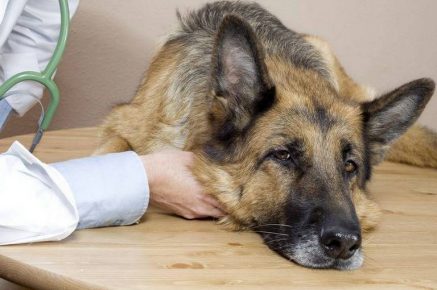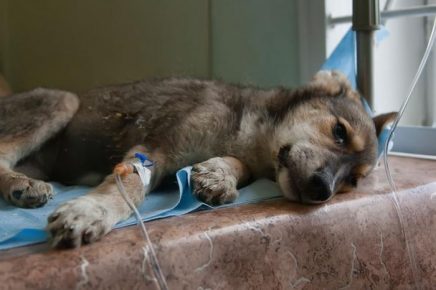By medical standards, enteritis is a disease relatively young. He is only 40 years old. Enteritis in dogs has been diagnosed since 1978 years when the disease was described by American veterinarians. In a couple of years the first case of the disease was recorded in the Soviet Union. AT today’s Russia enteritis is among the “five” most often encountered canine ailments. Insidious disease affects the intestines animal, and then destroys the rest of the body. At the heart of enteritis is a virus. As he progresses, he strikes the vital dog organs. From the enteritis, after the intestines, the liver and kidneys suffer and heart.
Content
- 1 Types of Enteritis in Dogs
- 2 Reasons
- 3 Symptoms
- 4 What is a disease dangerous
- 5 Diagnostics
- 6 Treatment
- 6.1 Medicines
- 6.2 Folk remedies
- 6.3 Power
- 7 Possible complications
- 8 Prevention
- 8.1 Responses of dog owners about enteritis
- 8.2 Enteritis in dogs on video
Types of enteritis in dogs
Contents
Today enteritis is one of the most common diseases of dogs. Alas, despite all the efforts of the doctor and the owners, it is possible to cure him rarely, and the animal dies. The thing is that the disease requires immediate treatment, but so quickly start it physically impossible – to track an illness right away sometimes just unreal.
Enteritis is primary (a lesion occurs with it intestines) or secondary (as a result of another disease and ingestion of an animal infection).

The secondary form of enteritis is diagnosed in dogs 2 times more often
The following species are distinguished depending on the pathogen. enteritis:
- Rotavirus. A type of intestinal infection. With her, a sharp increase in temperature occurs almost immediately the body of a sick animal (up to 40 ° C).
- Coronavirus. They are caused by viruses, belonging to the coronavirus family. They are less dangerous by compared with other pathogens of the disease. The hardest thing to treat coronaviruses are situations when it joins the disease and some other, “additional” infection. In light form coronavirus enteritis in adult dogs can even pass undetected to humans.
- Viral Their treatment is a serious matter, it must be carried out exclusively under the supervision of a veterinarian and only with the help of drugs, without any “medicine prescriptions.”
- Hemorrhagic. Distinctive feature – illness It proceeds not only in an acute form, but also in a fairly light form. What, however, does not negate the need for serious treatment.
- Spicy. A disease that leads to rapid dehydration. Combined with vomiting and persistent with diarrhea it exhausts a sick dog so much that in a day it can turn into a skeleton – “skin and bones.”
- Parvovirus. This type of enteritis is most common and dangerous. This disease occurs in dogs. swiftly. Treat the animal as quickly as possible, otherwise In the event of a disease, death may result. Diagnostics parvovirus enteritis in dogs is based on laboratory research.
Causes
Domestic dog can pick up enteritis from its infectious stray brothers. Sometimes it’s enough to get infected sniff at a randomly met stray dog or those met on other dog’s vital products: their bowel movements, vomiting or remnants of saliva. Recently, veterinarians published frightening statistics that speak of striking power enteroviruses. It turns out that only 1 g of animal vomit can provoke infection in up to a million dogs. Fortunately in reality indicators are much lower.
Dogs become carriers of infection already in the incubation period (4-10 days).
Another option is to get sick when the virus enters the body of the animal along with food or contaminated water. It is believed that even indoor animals are not safe from the disease. dogs that go for a walk exclusively in their arms the owner. They can pick up an infection from a person’s clothes or, for example, sniffing the shoes of guests at home.

One of the main causes of enteritis in dogs is the lack of vaccinations
Symptoms
The first signs that the owner of the animal notices similar to the symptoms of many other diseases. Suddenly the four-legged friend becomes lethargic. She doesn’t want to eat or play. More lies. Moves a little. He doesn’t even look at his favorite treats. Then diarrhea begins.
During the day, the dog can empty the stomach up to 5 times.
A shooting chair with a specific and extremely unpleasant odor. The owner of the animal should pay attention to the color of feces. If he dark yellow, it can be established almost unmistakably: in a dog – rotavirus enteritis.
Further, a sick animal rises in temperature. Can vomiting begins (often with foam). Frightening changes are taking place. integuments – those unexpectedly lose their elasticity. Lymph nodes increase, the level of leukocytes in the blood decreases (about as evidenced by a blood test).
The next day, the four-legged friend continues vomiting and diarrhea, shortness of breath and fever are added to them. Despite this, the dog may try to eat, but does it while lying down.

Due to rotting inside the long intestine of food and related severe intoxication the smell of feces fetid
The disease is characterized by a rapid course. The incubation period of enteritis in dogs lasts from 1 to 5 days. Of this enough time for the virus to invade and begin destruction intestinal mucosa. His edema begins, and then the stomach. The digestive process fails. Cease absorbed nutrients. One of the first symptoms is pathogens appearing in pet secretions approximately 3-4 days after infection.
What is the disease dangerous?
Especially dangerous disease for puppies – from 2 weeks to 3 months. It’s very difficult to save the kids The sad result for them, alas, is almost a foregone conclusion. Puppies from 5 months and up to 1 year is also in a high risk zone, for their life desperate to fight. Dogs from a year and older have every chance to win the disease – with the right treatment, which is started at the right moment.
Enteritis in dogs is not contagious to humans. Animal owners a terrible disease will not be transmitted. The place of keeping a sick dog must be in perfect condition. An infection dies when it is affected by any preparations containing chlorine.
Diagnostics
It’s difficult to diagnose enteritis in dogs because it appears literally from nowhere. Owner the animal cannot understand the reason why the dog suddenly fell ill: because neither dietary changes nor stressful ones preceded this situations, neither features of walking and change of routes.
When establishing a diagnosis, epizootological data for region.
In addition, in order to diagnose enteritis, it is necessary to carry out laboratory research analyzes. And in time of illness, they simply do not exist, although it is necessary to take the animal feces for research required.

When diagnosing, the veterinarian differentiates viral enteritis in dogs from parasitic and alimentary gastroenteritis, viral hepatitis and intestinal plague
In the laboratory, it will be possible to establish the causes of symptoms. Or mistakes in feeding the pet are to blame for everything (it happens and such) or vomiting with diarrhea – the result of the action of the virus.
Treatment
A sick animal must be immediately isolated from others. pets. Provide comfort, no drafts and immediately proceed to save the four-legged.
Enema helps free the intestines from rotting masses. But with her you need to be very careful, monitor the condition of the animal.
Experts argue where it is better to treat the patient – at home or in vet clinic. At the same time, many are inclined in favor of the fact that treatment enteritis in dogs should be carried out at home. Moving to the hospital will make the four-legged suffer stress, which during a serious illness will be superfluous.
The course of treatment of the animal, its result, as well as the duration of the procedures that will be required depends on several factors. Among them are the following indicators:
- how strong is the virus that has entered the dog’s body;
- in what form was the dog at the time of infection, in what A condition has met the animal’s immunity virus;
- the intestinal condition that the dog had before the disease had whether the place is any deviation.

Saline solutions are given to restore water-salt balance disturbed by persistent vomiting and diarrhea
During treatment of enteritis in dogs, specialists and owners animals should determine their main goals:
- defeat the virus (with medication);
- remove toxins from the body;
- help the animal restore the right amount of fluid (do it will have to be through a syringe, and it’s important to remember: the water that is given sick beast must be boiled and, of course, without gas);
- maintain immunity (he enters the battle with the virus immediately, because accumulate antibodies to counter the disease is obtained not earlier, than after 5-6 days);
- help restore the work of the stomach and intestines, heart.
The effect of the treatment started should be felt already through day after the dog entered the struggle for the life of the dog person.
The 5-6th days of the disease become decisive when in the body the dog completes the production of antibodies.
Complete restoration of the animal is not a quick process. Owner dogs will need to help a four-legged friend get better with using medicines, traditional medicine, and also correctly compiled diet.
Medication
Scientists have yet discovered a universal remedy for enteritis in dogs did not come up. Today they use for treatment a set of measures and a variety of medicines.
At the very beginning of the disease, drugs are administered using intravenous injections – the only way to achieve the effect. If do it intramuscularly, then at this stage they simply will not absorbed, then they can’t start working.

Activated carbon and white are given as enterosorbents. clay so that they adsorb toxins formed on the surface during rotting feed
In the medicinal arsenal – serum and immunoglobulins, containing antibodies to pathogens. How much drug must be introduced to the dog, the attending physician expects. At the same time he takes into account the weight of the dog. Usually on the first day of the start of treatment for injections more are prescribed, and their decrease occurs already from the second day. Injection courses can be designed for up to two weeks.
Among the drugs that are almost always included in the list drug treatment, we can distinguish:
- Antibiotics. They cannot destroy the virus, and it’s up to them to maintain a stable state of the animal. In addition, they kill foreign bacteria, which reduces the risk the occurrence of complications.
- Chloramphenicol. Unlike other means and antibiotics, it is much more effective and suitable for application even in the most severe cases.
- Serum. Immune drug action which is designed for a short time. Helps well in combination with other medicines.
- Tserukal. Antiemetic drug with its own features. For example, it cannot be used in cases when it is sick little puppy. There is a limitation on the terms of application: it is impossible use longer than a week (with three times a day).
This mandatory list of drugs does not end there. Veterinarians remind: in parallel, the pet must receive and vitamins, and with them, drugs that support the liver and heart.
Folk remedies
Some owners fear that “chemistry” will only hurt animal, and are taken for the treatment of enteritis in folk dogs means. Bark Extract Really May Be Helpful oak for enteritis in dogs, as well as flax seeds with enveloping and astringent action.
I must admit: homeopathy alone is not a pet will help. To cure the dog, you have to use and medicines.
Food
It is necessary to give food to the animal from the moment it succeeds curb and stop vomiting. To know what to feed after enteritis, it is necessary to consult with specialist. Diet for the patient – exclusively dietary. The portions are small and fractional. An important point: Never force food into the dog’s mouth. Gotta so that she herself showed even the slightest desire to eat. During the period disease and treatment is important:
- add “milk” to the dog’s diet – kefir, cottage cheese and yogurt;
- cook chicken stock for the four-legged patient (the main thing is not overdo it: the soup should not be too fat);
- limit your intake of carbohydrates;
- Add new products gradually. For example, boiled meat, cereals and boiled vegetables can begin to be offered to the pet later a week after the appetite returned.
Possible complications
The recovery period also imposes restrictions on food. Dog cannot be fed sausage, sweets, baked goods, products with spices, fish and meat with bones. Healthy and Diet Food Become a Companion the dog for a long time, because with enteritis it is seriously suffering the gastrointestinal tract, and after defeating the disease, it needs to be will be treated very carefully. Otherwise may occur complications.

In bitches, enteritis can cause reproductive complications. the system
Most often about transferred enteritis in dogs remind:
- lameness of the dog (it can persist for several months, and sometimes for life);
- polyps in the oral cavity (they will have to be removed surgically by way);
- heart disease – myocarditis (a consequence of enteritis, transferred at a very young age up to 9 weeks).
If the disease was not very serious, all these consequences should to pass during the year – by themselves.
Prevention
As prevention of enteritis in dogs, only vaccination of an animal. Protection against the virus are poly- and monovalent vaccines. Guaranteed that after vaccination the dog does not get sick – high enough.
According to statistics, the risk of infection in vaccinated dogs is 5%.
However, even in case of illness, defeat him after vaccination. It turns out to be much simpler. In addition, practically the risk of death is completely excluded.
Vaccination takes place in five stages. The first injection is done monthly puppies, the second – at two months, the third – at three. Fourth stage guess by the time when the animal undergoes a change of teeth. The fifth vaccine is planned 11 months after the fourth. Further vaccination is carried out annually.

General preventive methods are aimed at maintaining necessary hygiene conditions
To reduce the risk of infection of the smallest animals, people must comply with the following rules:
- Do not walk unvaccinated puppies on the street;
- puppies should not be given the opportunity to sniff housekeeping shoes and clothes
- Before stroking the pet, the owner must wash his hands with soap;
- It’s useful to set up temporary quarantine at home – to keep it out outsiders until the dog was vaccinated.
Dog Owner Reviews for Enteritis
A friend of the dog had enteritis. They gave pills, set droppers, she constantly lay, was sluggish, lost weight and did not want to there is. Because a friend urgently needed to leave for another city, a dog left us for overexposure. When they went out with her for a walk, she lay down and lay. It was necessary to feed her only chicken with rice, she at first completely refused food and constantly either slept or lay. A few days later she began to come to life, come to us, there is a little bit. Then she recovered completely, even began to have our food trying to take away, playful became. The mistress returned and did not recognize her.
We had small enteritis after the first vaccination. Once night tear start 4 times, I immediately legs in hand. We did a test for enteritis in the clinic (smeared and after 3 minutes the result). We fought for a long time. They gave the treatment regimen in the clinic, she did everything herself. Originally Of course, they helped and put a catheter into a vein. How many injections horror was done! Thanks, my son also helped. The water was first removed because just drink and immediately vomit. I haven’t eaten for a week. It was scary death. Now she is 6 months old. nearly. And puppies are getting worse.
Our first Great Dane at 4 months died from enteritis .. we slammed puppy with our rural veterinarians who pricked him with azidine from a tick .., after Black, I had more than 10 dogs .. but we learned to treat this infection. So: the dog has diarrhea – right away give a tablet of LEVOMECITIN if the diarrhea has not stopped (but usually helps 100%) and vomiting started, do the following – stab in the thigh intramuscularly: human immunoglobulin (in Russia, it seems prescription) 1 time per day – a maximum of 3 days sulfacamphocaine (for heart maintenance) 2 times a day gentamicin (antibiotic) 2 times a day usually after injections after a while the dog falls asleep. I stabbed by 1 ampoule of each drug (but I had Caucasians and watchdogs) in same time – to take control of diarrhea – do an enema – on liter of water a handful of pharmacy chamomile – boil, cool until slightly warm state, lubricate the tip of the enema with oil (petroleum jelly) and make a couple of big enemas – immediately put the dog on the lawn – with bloody diarrhea will go strongly on her. After an hour, repeat the enema, later after 2 hours – as a result, soon the chamomile liquid will go – blood will go away (chamomile heals wounds and prevents dehydration organism) from vomiting give mineral water without gas (but I do not give – gave a camomile) also all the time to give divorced in water activated carbon – a pack in a glass of water. Usually with treatment on day 3-5 comes recovery. During this period not give meat and dairy products !! only broth and rice soups (rice fixes). Meat can be given 10 days after recovery. You can give a raw egg whipped with sugar. So again levomecithin 1 TB – 3 times a day activated carbon injections Immunoglobulin, gentamicin and sulfocamphocaine 2 times a day (except immunoglobulin) several times a day – in a strong stage illness 5-6 times a day, later 3 times a day feeding – broth, rice soup, raw egg – DO NOT FORCE FORCE !! not to eat grass !!! this treatment saved a lot of dogs!
Enteritis in dogs on video
Veterinarians claim that some kind of predisposition there is no specific breed of dog for enteritis. But the features the course of the disease is observed. Extremely hard ailment strikes Dobermans, as well as East European Shepherd Dogs. Sure, the animal has an extremely difficult time. Masters looking at suffering and fading pet, do not find a place for themselves. But keep fighting for so that the pet recovers, becomes vigorous and cheerful again, necessary. Together, it is possible to defeat enteritis.






